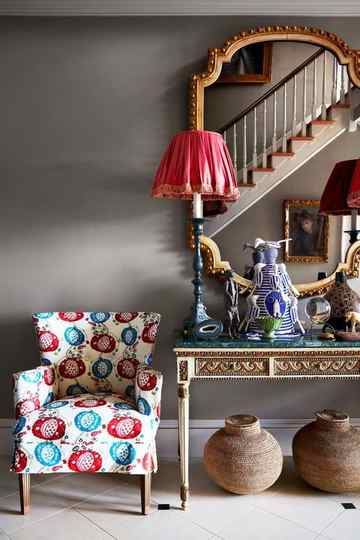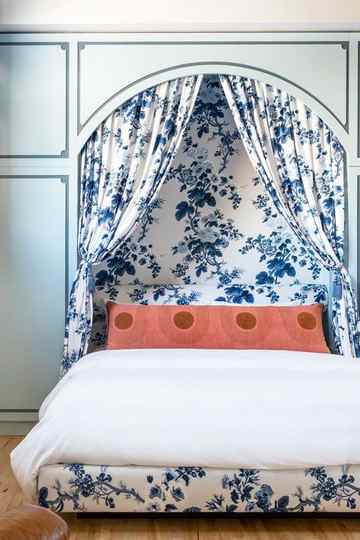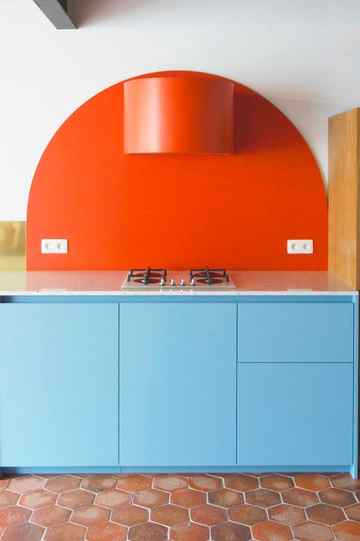The lesson here is that blue looks good with literally every color in the rainbow. Designed by Kingston Lafferty, the artwork above the fireplace sets the tone for the bold color-blocking happening throughout the space, including the light green ceiling, the tonal walls and mantel, the sputnik light, and the patterned chairs and drapes.
What Colors Make Blue?

While every color is unique in its own way, there is something special about the blue hue. It is a color that attracts the eye, calms the brain, and makes it impossible for us to yank our gaze away from its tranquil beauty.
This color has been proven to induce feelings of ease and calmness, which is why many medical logos are blue. Alongside making us feel calm and serene, blue also evokes feelings of stability, orderliness, and confidence.
Unsurprisingly, then, the color blue is such an integral part of the natural world and it never fails to leave us mesmerized and awestruck.
In this post we’ll be going over what colors make blue.
What Colors Make Blue?
Actually, creating blue only needs a combination of two colors. Once you understand the genuine blue creation formula, you can combine paint colors to produce any blue-inspired color you can think of.
Blue, alongside green and red, makes up the primary color tri-fecta. In other words, blue is a color that can be blended to create all other colors of the rainbow in different ratios. Remembering that combining all the primary colors will result in white can help you make sense of this.

Because blue is a primary color, a common misconception is that it cannot be created by the use of color blending. This is untrue. We can actually create primary colors by mixing cyan, magenta, and yellow pigments based on the CMY subtractive color model.
What colors do you combine to make blue? The color blue is created by combining the colors magenta and cyan. While cyan is a greenish-blue, magenta is a kind of purplish-red that lies between the red and purple wavelengths.

Mixing Different Shades of Blue
Once you reach blue, the options for building a rich spectrum of regal, calm, sea-inspired, and sky-evoking blue colors are essentially unlimited. You must combine the appropriate color formulas to achieve your desired outcomes; therefore, in this instance art really does function like a science.
When they wish to fill bare spots on walls or canvases with hues of turquoise, cobalt, or aquamarine, interior designers and artists frequently create unique colors on the spot. They accomplish this by emphasizing or downplaying specific qualities of blue using different hues from the color wheel.
This is how you can create the most common shades of blue:
- Navy = Orange + Black + Blue
- Royal = Black + Purple + Blue
- Cornflower = Gray + Blue
- Teal = Green +Blue
- Turquoise = White + Green + Blue
- Cobalt = Turquoise + Ultramarine
- Cerulean = White + Cobalt
- Indigo = Red + Blue
- Powder Blue = White + Royal Blue
What is a primary color?

The first thing worth noting is that red and blue are primary colors.
But what is a primary color, anyway? You probably covered this back in elementary school, but here’s a quick refresher.
Primary colors are the only colors you can’t get by mixing other colors together. However, you can make any other color with a combination of primary colors. (Sometimes, you’ll also need to add a secondary color to get the right shade).

You might not know this, but there are two color systems – one for mixing light and one for mixing pigments. Each color system has its own primary colors.
In the additive color system (i.e., when mixing light), the final primary color is green. So, the primary colors in additive color mixing are red, blue, and green.

But you’re more likely to be familiar with the subtractive color system. It applies to any type of paint, pencil, dye, ink, or pigment. And in this system, yellow is the third primary color.

These are the more well-known primary colors red, blue, and yellow. They apply to any subtractive color mixing.
The Color Red

Red is a fiery, bright, and eye-catching color. It can signify many different things, from warmth and love to passion, anger, and even danger.
As mentioned, red is a primary color. So, it’s crucial to have it if you want to mix other colors.
And red is also a warmer color. You’ll find it between orange and purple on the color wheel. Its complementary color (opposite on the color wheel) is green. You can find out more about mixing red and green here.
The Color Blue

In contrast, blue is a calm, soothing color. It’s common in nature, from the sky to the sea, rivers, and lakes.
There are many different shades of blue. Often, artists will use the color blue to create a serene atmosphere.
Blue is a cool temperature color found between green and purple on the color wheel. Its complementary color is orange.
Red and Gray-Brown

House Beautiful
Kim Alexandruik’s motto is, “Go for impact.” Use an entry or hallway as an excuse to play with unusual seating and colorful artwork that may be harder to integrate into other rooms. Her color of choice is a “putty-colored gray, with a hint of pink and lavender. Not too light, so it doesn’t go vapid,” says Aleandruik. Use this hallway designed by Mally Skok, which incorporates gray-brown, red, and several shades of blue, as inspiration.
Advertisement – Continue Reading Below
Burnt Orage

Laure Joilet
If you weren’t sure you wanted to use blue in your bedroom before, you probably do now. ETC.etera gave classic blue and white toile a new life by mixing it with cheeky faux molding walls and a geometric burnt orange pillow.
Tangerine

Dries Otten
Country-style terra-cotta tiles get a modern update in this kitchen designed by Dries Otten with a playful bright orange backsplash and sky blue cabinetry. Sky blue and bright tangerine sit opposite one another on the color wheel, which makes them perfect complements. Here’s how the combo plays out in a fun, well-designed kitchen.





